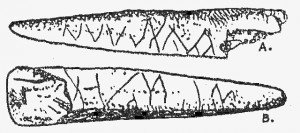The Oldest Relic of Runic Writing in the Carpathian Basin
Klára Friedrich
The oldest relic in Hungary so far, the end-piece of a staff with runic script, was found in the Pilis mountain-range near the village of Bajót. I discovered its picture in a book entitled: The Prehistoric Man, written by Kálmán Lambrecht (Edition Dante, 1931). I published this picture on page 115 of a book, co-authored by Gábor Szakács: Tászok-tetőtől a bosnyák piramisokig, Budapest. 2007 (From the Summit of Tászok to the Bosnian Pyramids). I also included this on page 283 of another publication: Magyarságtudományi tanulmányok and page 303 of Selected Studies in Hungarian History, edited by László Botos. (Budapest 2008) (Abstract)
Only the following is found about the end-piece of the staff in Kálmán Lambrecht’s splendid book: "The vestige of prehistoric man’s art in Hungary – a zigzag-adorned stick from the Magdalenian cultural stratum in the Jankovich cavern of Bajót. Original size."
To sum up, Kálmán Lambrecht concluded the scores to be purely ornamental. In my opinion, however, we can perceive them as well-identifiable letters of our ancestral writing. Consequently, I strove to learn as much as possible about this find. László Vértes stated in his book: The Relics of the Paleolithic Age and the Transitional Stone Age in Hungary (Academic Edition, 1965):
"The finds in the Jankovich cavern constitute, on the Danube’s west side, the only aggregate of the Szeleta age that can be measured statistically. The cavern, which opens toward the north below the peak of Öregkő in the vicinity of Bajót, was excavated by Hillebrand from 1913 to 1925,...."
We can obtain some knowledge about the personage of the explorer, Jenő Hillebrand (1884–1950), also from László Vértes:
"...the pre-historic archeologist’s...refined logic, his professional attainments and, last but not least, his love of his profession built the system of the Hungarian prehistoric findings, and made their valuable subject matter well-known."
In his book, The Prehistory of Hungary (Budapest, 1935), Hillebrand does not include a description of this find, yet shows it among his photographs.
In the literature, the period of the find in the Jankovich cavern is set between the Magdalenian and the Szeleta ages, namely, between 15,000 and 41,000 years ago. Hence, the age of the end-piece of our staff is placed between these two periods. No mention is made, however, about the material of the staff’s end-piece. By taking into consideration its age, it is likely that the find was polished from bone or from an antler. The stipulation about the find’s age and material is supported by spear-tips from the cave of Istállóskő in the Bükk mountain. These, too, were made from bones or antlers, albeit without markings, and can be viewed at the Hungarian National Museum. The age of these varies from 30,000 to 35,000 years.
Kálmán Lambrecht declares the drawing appearing in his book to be of original [i.e. same] size. Based on this, the broken end of the staff is 38 mm long and is 8 mm broad at its widest part. Its function may have been the tip of a spear.

The signs on the `A” side (above) are, from right to left left: clever ligature of the letters SK, grouping of G or BG, ingenious assemblage of letters BSO, as well as K and V, or two figures of five and the letter K.
The signs on the `B" side (below) are, from right to left: ligature of the letters V and L, grouping of SV and two V signs, then another ligature of BR before the fracture.
The above identification of letters is only valid, naturally, if the drawing is accurate. It is very likely that the broken-off missing part also contained markings. In my opinion, the writing started on the `A" side of the stick, advancing toward the pointed end, then continued on the `B" side, starting at its point.
The importance of the find constitutes our oldest written relic in the Carpathian Basin. On it, the letters of the Szekler-Magyar [i.e. Hungarian] runic script, still used today, are recognizable and maybe even a word. From all this, the following significant conclusion can be derived pertaining to our prehistory: in one respect, we can support our very early presence in the Carpathian Basin with significantly older script than that on the Tatárlaka disk [in Transylvania]; in another respect, the Hungarians already used, during that period, the most advanced method of recording letters, where each sound is represented by a unique character. With this method, messages can be created with ease, unlike with the cumbersome picture-writing, ideogram, or syllabic script.
I would like to thank Susan Tomory for the following thoughts:
"The zig-zag lines are part of the symbolism of the Székely-Magyar group, and also part of their symbolic plants – the carnations and the grape leaves. So we can not only read this script, but also know which ethnic group wrote the signs. We may read further data concerning the Székely symbolism in Adorján Magyar’s Az ősműveltség (The Ancient Culture). Another splendid example of this ethnic group’s ancient presence in the Carpathian Basin is the statue of the Tűzköves man, holding a sickle (with zig-zag edges) on his shoulders, his attire decorated with zig-zag lines."
Translated by: Károly Bartha
Source: magtudin.org
Editor's note: Text reformatted to enhance readability. The picture embedded in this document was unavailable from this source. The image shown is taken from our files and confirmed on page 303 of Selected Studies in Hungarian History, where side "B" is above side "A," and side "B" is left-right reversed. (Abstract)


